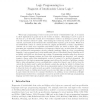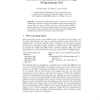14 search results - page 2 / 3 » The logic of tied implications, part 2: Syntax |
LICS
1991
IEEE
13 years 8 months ago
1991
IEEE
When logic programming is based on the proof theory of intuitionistic logic, it is natural to allow implications in goals and in the bodies of clauses. Attempting to prove a goal ...
ICLP
2007
Springer
13 years 9 months ago
2007
Springer
We present the CIFFWEB system, an innovative tool for the verification of web sites, relying upon abductive logic programming. The system allows the user to define rules that a web...
UML
1998
Springer
13 years 9 months ago
1998
Springer
The object Constraint Language (OCL), which forms part of the UML set of modelling notations, is a precise, textual language for expressing constraints that cannot be shown diagram...
CADE
2006
Springer
14 years 5 months ago
2006
Springer
CEL (Classifier for EL) is a reasoner for the small description logic EL+ which can be used to compute the subsumption hierarchy induced by EL+ ontologies. The most distinguishing ...
PODC
2012
ACM
11 years 7 months ago
2012
ACM
This work presents a classification of weak models of distributed computing. We focus on deterministic distributed algorithms, and we study models of computing that are weaker ve...


